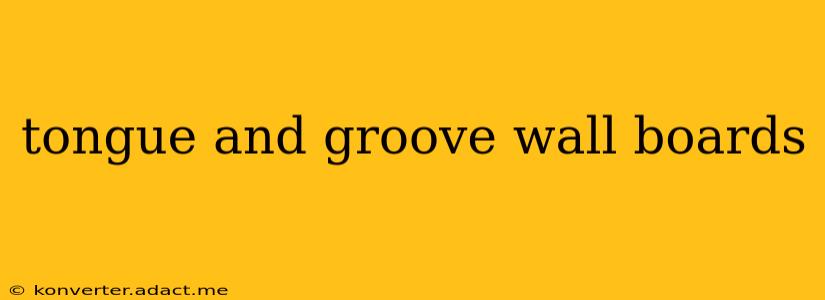Tongue and groove wall boards offer a classic, timeless aesthetic with a range of practical benefits. This comprehensive guide explores everything you need to know about this popular cladding option, from understanding the different types available to installation tips and maintenance advice. Whether you're a seasoned DIY enthusiast or a first-time homeowner, this guide will equip you with the knowledge to make informed decisions about incorporating tongue and groove wall boards into your project.
What are Tongue and Groove Wall Boards?
Tongue and groove wall boards are a type of paneling characterized by a unique interlocking system. Each board features a protruding "tongue" on one edge and a recessed "groove" on the other. This ingenious design allows the boards to fit snugly together, creating a seamless and visually appealing surface. The tight fit also helps to minimize drafts and improve insulation, contributing to a more energy-efficient home.
Different Types of Tongue and Groove Wall Boards
The market offers a variety of tongue and groove wall boards, each with its own unique characteristics and applications. Understanding these differences is crucial for choosing the right material for your specific needs.
Material:
- Wood: The most traditional option, offering a natural look and feel. Popular wood choices include pine, cedar, redwood, and oak, each with varying levels of durability and cost.
- MDF (Medium-Density Fiberboard): A more affordable and readily available alternative to wood, MDF tongue and groove boards are smooth and easy to work with, but less durable and susceptible to moisture damage.
- PVC (Polyvinyl Chloride): A durable, waterproof, and low-maintenance option. PVC tongue and groove is ideal for damp environments like bathrooms and kitchens.
- Composite Materials: Blending wood fibers with other materials creates boards with enhanced durability and resistance to moisture, insects, and decay.
Profile:
The profile refers to the shape and style of the board. Common profiles include:
- Beaded: Features a raised bead along the center of the board.
- Shiplap: Overlapping boards create a rustic, farmhouse-style aesthetic.
- V-groove: A simple groove running down the center of each board.
- Square Edge: A clean, modern look with straight edges.
Choosing the Right Tongue and Groove Wall Boards for Your Project
Selecting the perfect tongue and groove wall boards involves considering several factors:
- Budget: Prices vary considerably depending on the material, profile, and finish.
- Style: Consider the overall aesthetic you wish to achieve. Rustic, modern, or traditional styles will influence your material and profile choice.
- Location: The environment where the boards will be installed (e.g., bathroom, bedroom, exterior) will dictate the required durability and moisture resistance.
- DIY Skills: Some materials and profiles are easier to install than others.
How to Install Tongue and Groove Wall Boards
Installing tongue and groove wall boards is a manageable DIY project for many homeowners. However, proper preparation and technique are essential for a successful outcome. A detailed step-by-step guide is beyond the scope of this article, but key considerations include:
- Accurate Measurements: Ensure precise measurements to minimize waste.
- Proper Preparation: The wall surface must be clean, smooth, and level.
- Appropriate Tools: Gather necessary tools such as a measuring tape, saw, nail gun or hammer, and level.
- Adhesive: Use construction adhesive for added strength and stability.
How to Clean and Maintain Tongue and Groove Wall Boards
Proper maintenance will prolong the life and beauty of your tongue and groove wall boards.
- Regular Cleaning: Dust regularly with a soft cloth or brush.
- Spot Cleaning: Address spills and stains promptly using appropriate cleaning solutions. Avoid harsh chemicals.
- Protection: For wooden boards, consider applying a sealant or varnish to protect against moisture and damage.
What are the Benefits of Using Tongue and Groove Wall Boards?
Tongue and groove wall boards offer several advantages:
- Aesthetic Appeal: Create a visually appealing and classic look.
- Easy Installation: Relatively straightforward to install compared to other cladding options.
- Insulation: Improved insulation properties contribute to energy efficiency.
- Durability: Depending on the material, tongue and groove boards can be incredibly durable and long-lasting.
- Versatility: Suitable for a wide range of interior and exterior applications.
Are Tongue and Groove Wall Boards Expensive?
The cost of tongue and groove wall boards varies greatly depending on factors like material, profile, and finish. While some budget-friendly options exist (e.g., MDF), premium wood options can be significantly more expensive. Considering the longevity and aesthetic value, many homeowners view them as a worthwhile investment.
Can I Install Tongue and Groove Wall Boards Myself?
Yes, many homeowners successfully install tongue and groove wall boards themselves. However, it's important to have basic DIY skills and access to the necessary tools. For large or complex projects, professional installation may be advisable.
What is the Best Wood for Tongue and Groove Wall Cladding?
The "best" wood depends on your priorities (budget, durability, aesthetic). Popular choices include pine (affordable, versatile), cedar (naturally resistant to rot and insects), and oak (durable and luxurious).
This guide provides a comprehensive overview of tongue and groove wall boards. Remember to always consult professional advice for complex installations or if working in challenging environments. With proper planning and execution, tongue and groove wall boards can transform your space into a beautiful and functional environment.
